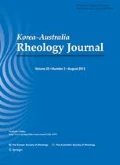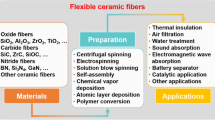Abstract
Breakup of fluid threads is omnipresent in nature and highly relevant for technical processes such as atomization, printing, coating, or spinning. We discuss how to control the filament lifetime of shear-thinning, viscoelastic fluids during uniaxial extension without affecting their shear viscosity. Two commercial acrylic thickeners differing with respect to the co-polymerized hydrophobic monomers, and hence different hydrophobic intra- and intermolecular association, are mixed to obtain aqueous solutions with similar shear viscosity. The elongational relaxation time as determined by capillary breakup extensional rheometry, however, varies by almost two orders of magnitude. Filament lifetime of these solutions can be varied upon adding non-Brownian, plate-shaped particles, again without affecting shear viscosity. A trace amount of particles increases elongational relaxation time by about a factor of four. Car bodies are usually coated using high-speed rotary bell atomizers guaranteeing high transfer efficiency and high-quality appearance. We use the solutions and suspensions described above to investigate the effect of extensional viscosity on ligament formation at the bell edge as a decisive intermediate step prior to droplet formation. High-speed imaging reveals a logarithmic scaling of ligament length with extensional relaxation time for pure thickener solutions. In contrast, ligament length monotonically decreases with increasing particle concentration, i.e. extensional viscosity. Plate-shaped particles obviously act as defects promoting ligament breakup. Extended filament lifetimes are commonly observed during atomization and spraying as a consequence of fluid viscoelasticity. On the other hand, low viscosity fluid threads rupture quickly. Here, we demonstrate that a unique banding instability during extension of a low viscosity surfactant solution with no measurable elasticity leads to extremely long filament lifetimes and to the formation of remarkably long threads. Combining filament stretching and particle image velocimetry we found an unexpected heterogeneous, banded flow in opposing directions. This phenomenon is not limited to surfactant solutions but can also occur in biopolymer solutions, thus broadening the view on instabilities in complex elongational flows.
Similar content being viewed by others
References
Bhardwaj, A., E. Miller., and J.P. Rothstein, 2007, Filament stretching and capillary breakup extensional rheometry measurements of viscoelastic wormlike micelle solutions, J. Rheol.51, 693–719.
Böni, L., P. Fischer, L. Böcker, S. Kuster., and P.A. Rühs, 2016, Hagfish slime and mucin flow properties and their implications for defense, Sci. Rep.6, 30371.
Clasen, C., 2010, Capillary breakup extensional rheometry of semi-dilute polymer solutions, Korea-Aust. Rheol. J.5, 331–338.
Entov, V.M. and E.J. Hinch, 1997, Effect of a spectrum of relaxation times on the capillary thinning of a filament of elastic liquid, J. Non-Newton Fluid Mech.72, 31–53.
Kheirandish, S., I. Gubaydullin., and N. Willenbacher, 2009, Shear and elongational flow behavior of acrylic thickener solutions. Part II: Effect of gel content, Rheol. Acta48, 397–407.
Martinie, L., H. Buggisch., and N. Willenbacher, 2013, Apparent elongational yield stress of soft matter, J. Rheol.57, 627–646.
Omidvar, R., A. Dalili, A. Mir., and H. Mohammadigoushki, 2018, Exploring sensitivity of the extensional flow to wormlike micellar structure, J. Non-Newton. Fluid Mech.252, 48–56.
Oswald, W., L. Gödeke, P. Ehrhard, and N. Willenbacher, 2019, Influence of the elongational flow resistance and pigmentation of coating fluids on high-speed rotary bell atomization, At. Sprays, being reviewed.
Oswald, W. and N. Willenbacher, 2019, Controlling elongational flow behavior of low viscosity complex fluids at constant shear viscosity, Rheol. Acta58, 687–698.
Recktenwald, S.M., S.J. Haward, A.Q. Shen., and N. Willenbacher, 2019, Heterogeneous flow inside threads of low viscosity flu ids leads to anomalous long filament lifetimes, Sci. Rep.9, 7110.
Rehage, H. and H. Hoffmann, 1982, Shear induced phase transitions in highly dilute aqueous detergent solutions, Rheol. Acta21, 561–563.
Rodd, L.E., T.P. Scott, J.J. Cooper-White, and G.H. McKinley, 2005, Capillary break-up rheometry of low-viscosity elastic fluids, Appl. Rheol.15, 12–27.
Sachsenheimer, D., B. Hochstein, H. Buggisch., and N. Willen-bacher, 2012, Determination of axial forces during the capillary breakup of liquid filaments - The tilted CaBE. method., Rheol. Acta51, 909–923.
Sachsenheimer, D., C. Oelschlaeger, S. Müller, J. Küstner, S. Bindgen., and N. Willenbacher, 2014, Elongational deformation of wormlike micellar solutions, J. Rheol.58, 2017–2042.
Thielicke, W. and E.J. Stamhuis, 2014, PIVlab - Towards user-friendly, affordable and accurate digital particle image veloci-metry in MATLAB, J. Open Res. Softw.2, e30.
Utracki, L.A. and J. Lara, 1984, Extensional flow of mica-filled polyethylene, Polym. Compos.5, 44–51.
Weinberger, C.B. and J.D. Goddard, 1974, Extensional flow behavior of polymer solutions and particle suspensions in a spinning motion, Int. J. Multiph. Flow1, 465–486.
Acknowledgments
We appreciate financial support by BASF Coatings GmbH and the German Science Foundation DFG (grant number WI 3138/22-1).
Author information
Authors and Affiliations
Corresponding author
Additional information
Publisher's Note
Springer Nature remains neutral with regard to jurisdictional claims in published maps and institutional affiliations.
This paper is based on an invited lecture presented by the corresponding author at the 30th Anniversary Symposium of the Korean Society of Rheology (The 18th International Symposium on Applied Rheology (ISAR)), held on May 21-24, 2019, Seoul.
Rights and permissions
About this article
Cite this article
Oswald, W., Recktenwald, S.M. & Willenbacher, N. What controls filament thinning in uniaxial extension?. Korea-Aust. Rheol. J. 31, 195–201 (2019). https://doi.org/10.1007/s13367-019-0020-7
Received:
Revised:
Accepted:
Published:
Issue Date:
DOI: https://doi.org/10.1007/s13367-019-0020-7




